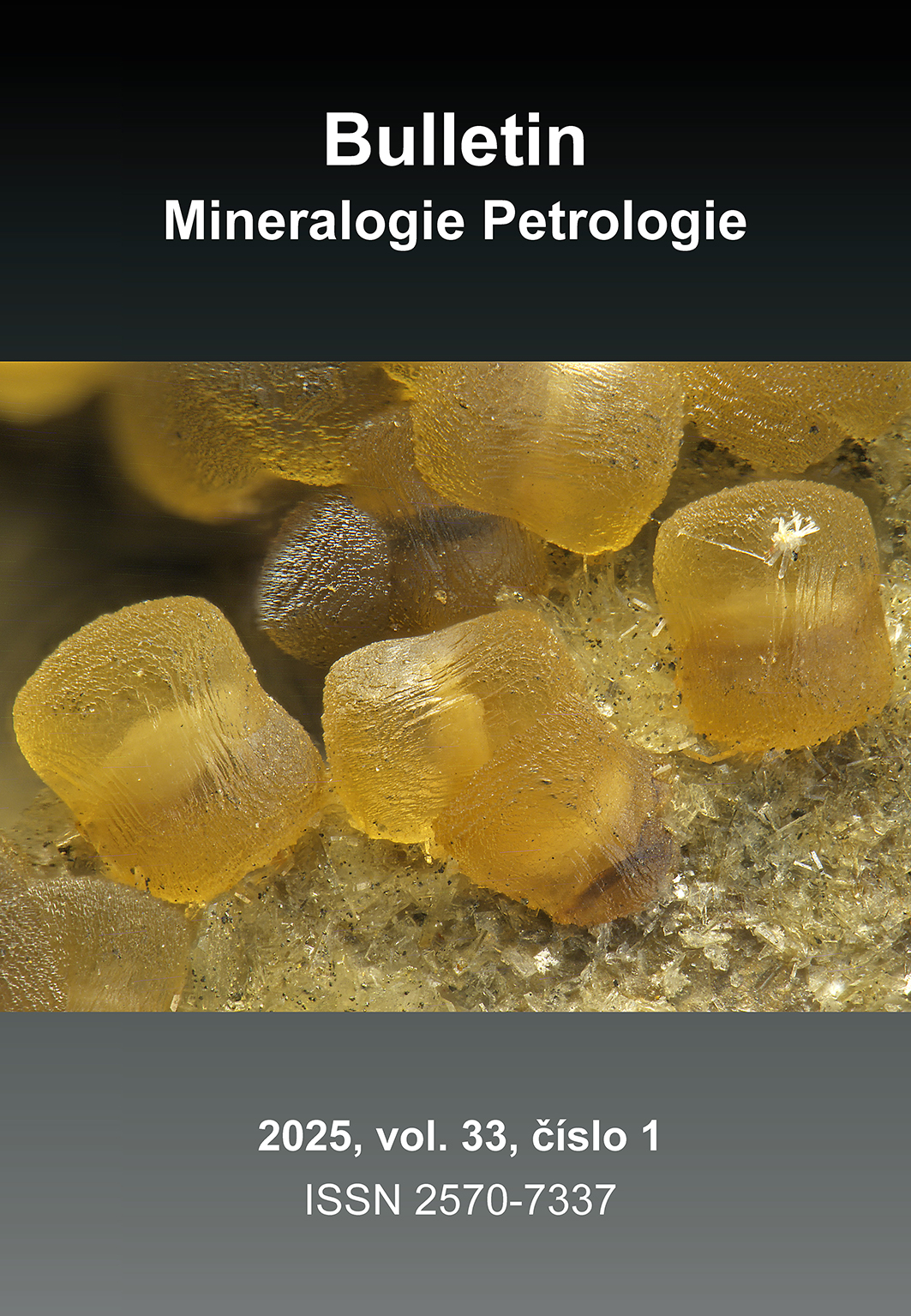Strusky z redukční tavby pelosideritové železné rudy realizované na hradě Buchlově (jv. Chřiby) v roce 2019: extrémní variabilita fázového složení a chemismu jednotlivých fází
Slags from smelting of pelosiderite iron ore realized at the Buchlov Castle Chřiby Mts., Czech Republic) in 2019: extreme variability of phase composition and chemistry of individual phases
Klíčová slova
Abstrakt
During experimental smelting of iron in a replica of historical shaft furnace, which was held at the Buchlov Castle in 2019, charcoal and fresh pelosiderite iron ore from the locality Moravany near Kyjov were used. The obtained furnace slag is practically completely formed by glass phase; only rare small domains contain also crystalline phases, whose occurrence is very irregular. A detailed study of chemical composition showed extreme heterogeneity in composition of glass and most crystalline phases. The glass phase contains variable, but often high amounts of Mn, Ca, Mg and sometimes P and/or K. The composition of olivine ranges widely among fayalite, dicalciumsilicate and tephroite (Fa1-91 Fo3-28Te2-45DCS1-52), as well as those of calcic pyroxene (Wo37-60Tsch1-13Ka8-22Fs4-30En14-36). Feldspars showed compositions between orthoclase and anorthite (Or2-82An9-91Ab5-19Cn0-2Slw0-2), which are unknown from natural systems. Minor components include wüstite, melilite (åkermanite with 1 - 6 mol. % gehlenite), leucite, kalsilite, locally also apatite and an unnamed phase with composition close to Ca2Al2Si3O11. The produced metallic iron is also compositionally heterogeneous and rich in phosphorus. The phase composition of slag differs significantly from those of typical iron slags. The reason can be seen in anomalous chemical composition of used ore, in too high temperatures during smelting (phase relations in metallic iron suggest temperatures around 1500 °C) in combination with rapid cooling of the furnace content after finishing of smelting, and probably also higher viscosity of slag melt. Both phase composition of slag as well as chemical composition of individual slag phases and metallic iron are significantly different from those of local historical artefacts from the period of usage of technology of direct production of iron. These findings do not support the idea that local pelosiderite iron ores were used for production of iron already during this early period.
Soubory
Reference
Adolf Z (2013) Teorie procesů při výrobě železa a oceli, část II – teorie ocelářských pochodů. VŠB – TU Ostrava
Bachmann HG (1982) The identification of slags from archaeological sites. Occasional publication No. 6, Institute of Archeology, London
Barák M (1995) Experimentální výroba železa v peci z doby Velké Moravy. MS, diplomová práce, VUT Brno
Bigham JM, Nordstrom DK (2000): Iron and aluminum hydroxysulfates from acid sulfate waters, in sulfate minerals: crystallography, geochemistry and environmental significance. Rev Mineral Geochem 40: 303-350
Deer WA, Howie RA, Zussman J (1963) Rock-forming minerals: Feldspars, vol. 4A. Geological Society of London
Dolníček Z, Kandrnál L, Ulmanová J, Vratislavská E, Hojač P (2019) Historická těžba pelosideritů na lokalitě Koryčanská cesta u Moravan, jižní Chřiby. Bull Mineral Petrolog 27: 304-316
Dolníček Z, Kandrnál L, Ulmanová J, Vratislavská E, Hojač P (2020) Strusky a železo z experimentální tavby železa realizované na hradě Buchlově (jv. Chřiby) v roce 2018. Bull Mineral Petrolog 28(1): 58-68. https://doi.org/10.46861/bmp.28.058
Donaldson CH (1976) An experimental investigation of olivine morphology. Contrib Mineral Petrol 57: 187-195
Dong XW, Wang H, Liu H, Qin JR (2003) Study on SO2 emission under various atmospheres during coal combustion. Acta Sci Circumst 23: 322-326
Gregerová M (1999) Petrografie technických hmot. MU Brno
Hošek J (2003) Metalografie ve službách archeologie. Archeologický ústav AV ČR Praha a Technická univerzita v Liberci
Krét J (2013) Základy teorie a technologie výroby železa a oceli, část železářství. VŠB – TU Ostrava
Křivánek J (2009) Inventarizace výskytů historických železářských strusek v oblasti Chřibů. MS, bakalářská práce, PřF UP Olomouc
Křivánek J (2015) Mineralogické studium artefaktů po železářské výrobě z vybraných lokalit v okolí Starého Města u Uherského Hradiště. MS, diplomová práce, PřF UP Olomouc
Morimoto N, Fabries J, Ferguson AK, Ginzburg IV, Ross M, Seifert FA, Zussman J (1989) Nomenclature of pyroxenes. Can Mineral 27: 143-156. https://doi.org/10.1180/minmag.1988.052.367.15
Mu H, Zhang T, Fruehan RJ, Webler BA (2018) Reduction of CaO and MgO slag components by Al in liquid Fe. Metallurg Material Transact B 49(4): 1665-1674. https://doi.org/10.1007/s11663-018-1294-8
Novotný P (2011) Celestin z okolí statku Zikmundov u Buchlovic. Zpr Vlast Muz Olom 301: 92-97
Okamoto H (1990) The Fe-P (iron-phosphorus) system. Bull Alloy Phase Diagr 11(4): 404-412
Pleiner R (1969) Experimental smelting of steel in early Medieval furnaces. Pam Archeol 60: 458-487
Pleiner R (2000) Iron in archeology: The European bloomery smelters. Archeologický ústav AV ČR, Praha
Pouchou JL, Pichoir F (1985) “PAP” (φρZ) procedure for improved quantitative microanalysis. In: Armstrong JT (ed.) Microbeam Analysis: 104-106. San Francisco Press, San Francisco
Roth Z, Matějka A (1953) Pelosiderity Moravskoslezských Beskyd. Geotechnica 16: 1-112
Stránský K, Souchopová V, Merta J (2000) Rekonstrukce pochodů přímé výroby železa z rud. Archeol techn 11: 12-21
Svoboda R (2014) Charakterizace železářských strusek z pokusné tavby realizované Technickým muzeem v Brně v r. 2012. MS, bakalářská práce, PřF UP Olomouc
Uhlíř D, Dolníček Z, Kolbinger D (2011) Rekognoskace a šlichová prospekce terénních pozůstatků po možné těžbě nerostných surovin na Hostýně (Hostýnské vrchy). Acta Mus Moraviae, Sci geol 96(1): 47-60
Vlasáková J (2015) Hydrotermální mineralizace v západní části Chřibů. MS, bakalářská práce, PřF UP Olomouc
Zmeškalová B. (2010) Mineralogické studium artefaktů po železářské výrobě v okolí Bystřice pod Hostýnem. MS, diplomová práce, PřF UP Olomouc
